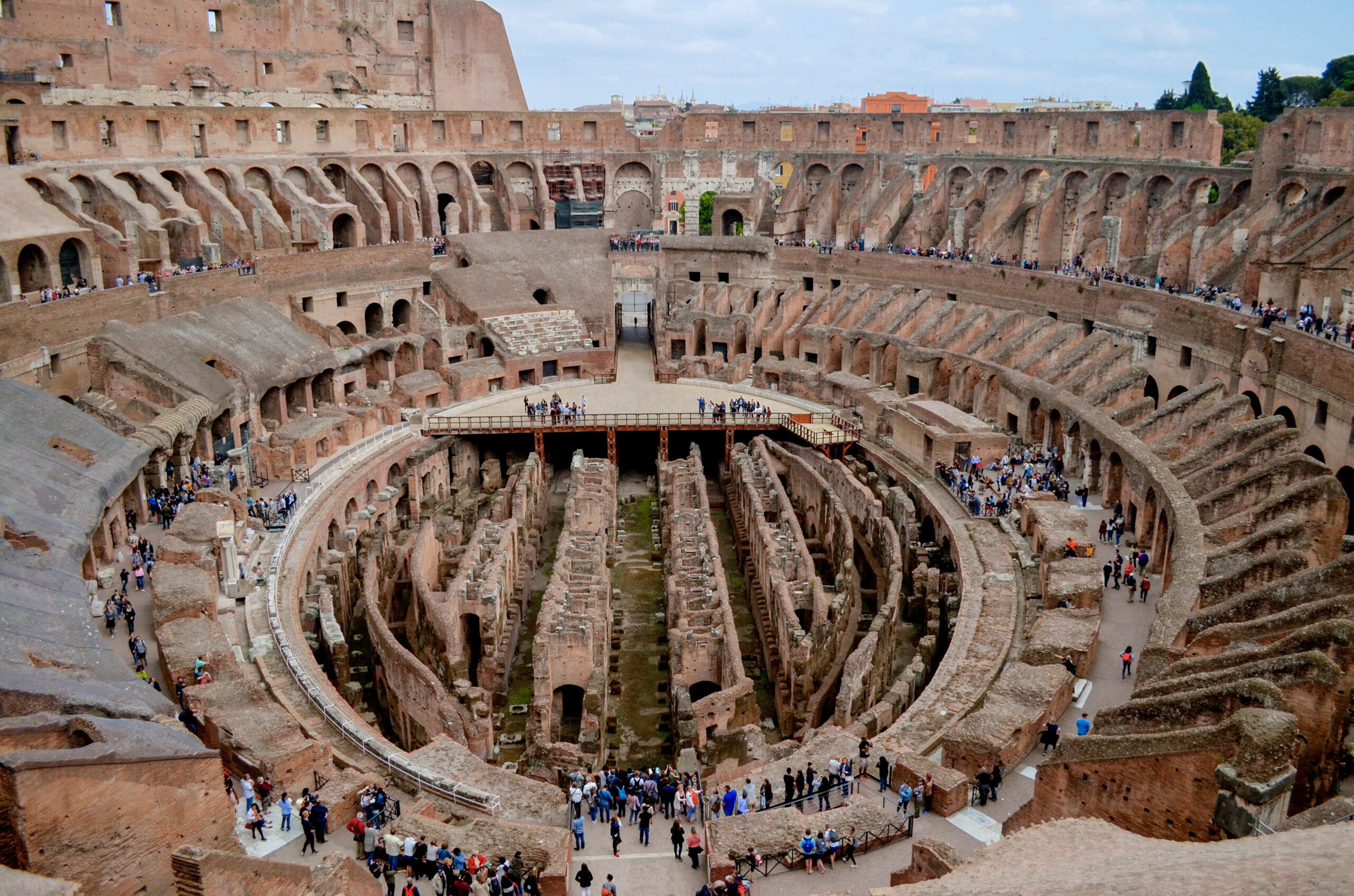We spent three days in Rome back in 2017 and fell head over heels in love with it. When we were planning our second trip to Italy in 2024, we knew we had to go back to Rome!
With stunning architecture, cobblestone streets lined with cafes, stunning cathedrals and innumerable historical monuments, Rome is a photographer’s paradise. This city is also a living, breathing museum where you encounter history at every turn!
Now everyone knows about the Colosseum and Vatican, but did you know there is so much more to the city beyond the tourist sites. Whether it is your first or second or third time, this guide is here to help you plan your itinerary. Since it was our second time here, we got plenty of time to explore some hidden gems, which I will cover in this article.
One biggest tip for planning a trip to Rome is to not do both Colosseum and Vatican on the same day. Both these places require a LOT of walking. By the time you are done and ready to go to the second one, you will already be exhausted!
One other important pointer – Rome is gearing up for Jubilee 2025 celebrations. During this year-long event, those of the Catholic faith are granted the special opportunity to seek plenary indulgence through pilgrimage to St. Peter’s Basilica and other historic churches in Rome. Being an important year for Catholics, the city is expecting at least three times the tourists it usually sees. Most of the city is undergoing a facelift and expect barricades and construction work at most tourist sites. While construction is expected to finish by the end of this year, be prepared for a very crowded Rome in 2025!
Since we had seen the main sites and monuments in their full glory on our first visit, we weren’t totally disappointed. But yes, if it is your first time in Rome, just be mindful of this. Despite all the construction work, we had a wonderful time in Rome.
For a general overview of our Italy itinerary please click here
Where to stay
The best areas to stay at are Piazza Navona, Campo de Fiori, Pantheon. They are the center of all action and most of the attractions are within walking distance.
If you want more of a local feel, then check out Trastevere neighborhood located across River Tiber. It has a list of restaurants, piazzas to chill at, churches, shops and an exciting nightlife. Even though Trastevere is slightly far, you can easily reach the main sites via public transport.
Monti, which used to be the red-light district in ancient Roman times, is now a hip neighborhood with cool bars, one-off boutiques and great restaurants. Prati (Vatican area) is quieter in the evenings and yet another great option to stay. If you are looking for budget options, then check out hotels near Stazione Termini (the main train station in Rome).
On our first trip to Rome, we stayed at an Airbnb in Monti district. It was less than 15 minutes-walk to the Colosseum and a 5 minute walk to the train station.
On our second trip, we wanted to save costs and use our credit card points. We stayed at AC Hotel Clodio Rome, located 15 minutes from Vatican area. The hotel was just three months old, and we were upgraded to the suite free of charge! Perfect way to end our two week-long trip 😊 I wouldn’t recommend this area for first timers since it is far from all the tourist spots. But if you don’t mind the commute (25-30 minutes to most tourist spots via bus), then certainly check it out. Even though slightly far, it worked out perfect for us.
How Many Days to Spend
If you plan your route properly, you can see most of the main sights (Colosseum, Pantheon, Trevi Fountain, Spanish Steps) in one day. And you can visit the rest (Vatican, Borghese gardens, etc.) the next day.
But if you really want to take in the city and not feel rushed, I recommend spending three days.
Transport in Rome
Rome’s subway – Lines A and B can take you to basically everywhere of interest. If you plan to take the train frequently during your stay, purchase the Roma Pass. It is available in 2-day (€36.5) and 3-day (€58.5) denominations. In addition to unlimited use of Metro and buses, it also covers some museums and discounted entry to other attractions. Depending on your itinerary, you may want to check if Roma Pass is worth purchasing.
Bus rides may take longer but are lot more economical. A single ticket costs €1.5 and is valid for 100 minutes. If you are going to take multiple bus rides during the day, then purchase the daily pass for €7.
You cannot buy tickets inside the bus but can buy them at metro stations, convenience stores and Tabacchi. Once you get on a bus, you need to validate the ticket. That means you need to insert your ticket in a small machine inside the bus which thereafter stamps it.
Rome also has trams in place. Sadly, there were not operational during our visit in September 2024 due to the ongoing Jubilee year construction work.
Things to see/ do
Colosseum, Palantine Hill and Roman Forum
The Colosseum was constructed between 72 and 80 AD. It is the largest ancient amphitheatre ever built and is still the largest standing amphitheatre in the world, despite its age.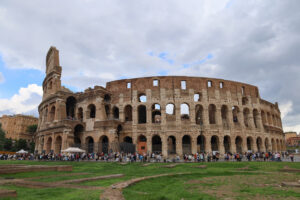
In the olden days, it was used for bullfights, gladiator fights, chariot races, public executions, official events and for various other forms of public entertainment. The capacity of the arena was 50,000 to 80,000 spectators. People were seated based on a very strict caste system, which separated the royalty and senators from the common man as well as the rich from the poor.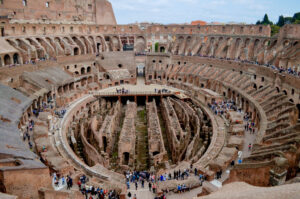
Sadly, almost two-thirds of the original amphitheater was destroyed over the centuries due to several natural disasters. But even with what is left of it today, it truly is an impressive piece of architecture! In fact, it is one of the most visited landmarks in Europe and one of the New 7 Wonders of the World.

While you can buy tickets at the site, advisable to buy skip the line tickets in advance so as to save time. This ticket grants access to the Colosseum, Roman Forum and Palatine Hill. The Colosseum is the focal point of visit for most tourists visiting Rome, so sometimes they can even get sold out. Look up time slots on the dates of your visit and book them right away!
Depending on the sites you plan to visit, you may want to check if it is more economical to buy the Rome Travel Card. Click here for more details.
There are a series of passages and rooms beneath the Colosseum where animals, gladiators and those sentenced to death would wait prior to entering the space. There are certain guided tours which grant you access to these otherwise restricted areas.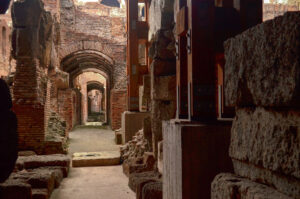
Just like skip the line tickets, these guided tours get sold out weeks or even months in advance! So, if you really intend to do one, book your tour beforehand. The prices for the guided tours (covering all areas of the Colosseum, Palantine Hill and Roman Forum) tend to vary by company but expect to pay around € 75 – € 110 per person.
Since we were keen to learn more about the Colosseum, we booked a guided tour on our first visit in 2017. We included the underground tour as well. We lucked out in securing tickets at the last minute with one of the tour companies.
Once you go inside, take your time marvelling at the engineering genius. Make sure to spend some time peeking through the arches on the second floor; there are some spectacular views from up there! Also watch out for the Arch of Constantine located right next to the Colosseum.
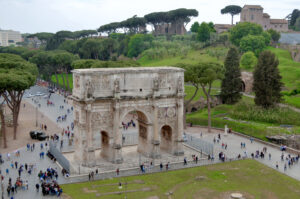
Looking to take instagrammable photos of the Colosseum from outside? Then head to Via Nicola Salvi, which provides a great perspective to capture its beauty from an elevated street. A little further up is Giardenetto del Monte Oppio which again is a great spot for those insta-worthy photos.
Once you are done with the Colosseum, make your make to Palatine Hill and the Forum. You will need to go through security again here. Once you are in, head left to go up towards Palatine Hill. The views from the hill are absolutely amazing.
Finally make your way to the Roman Forum. It used to be the center of city life in ancient Rome, where festivals, celebrations, funerals and rituals would take place. Although much of the Forum is now in ruins, you can see the remains and imagine the glory of the former temples and arches.

Touring the Colosseum, Palantine Hill and Roman Forum involves a lot of walking, so wear comfortable shoes.
As you make your way to Capitoline Hill, walk along Via dei Fori Imperiali. This old street goes between the Roman Forum and the Forum of Augustus and Trajan Forum and offers some great views.
Victor Emmanuel Monument / Altare della Patria
This is a massive white marble monument, which was built to honor King Victor Emmanuel, the first king of unified Italy. It was built between 1895 and 1911.
The Altare della Patria contains a lot of white marble from the region of Brescia. Because of how large it is (135 metres wide and 70 metres high) and the all-white structure, this building was given several nicknames, ranging from the wedding cake, the dentures, to the typewriter. A little fun fact – locals absolutely despite this structure!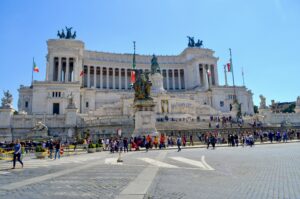
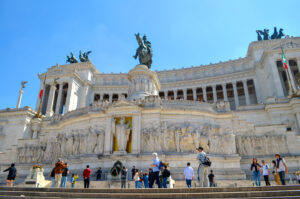
Given that it is located right next to the Roman Forum, you can easily add it to your itinerary.
Entry to the Victor Emmanuel Monument is free and you get some AMAZING views of the old city including the Colosseum, Roman Forum from the top.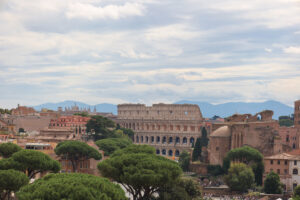
However, if you want an even better view, then take the elevator to the observation deck for a 360-degree view. It costs €15-30 and you can purchase your ticket on-site. I haven’t been but I have heard the views on a sunny day are truly spectacular.
Ara Coeli
On our second trip to Rome, we spotted this staircase right next to Altare Della Patria monument.
The 124 steps leading up to the church piqued our curiosity and decided to check it out. There is another less daunting way to get in (more on that later).
Once you reach the top and enter the basilica, you can admire stunning frescoes and the intricate architecture.
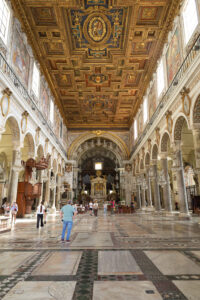
Campidoglio
Campidoglio is a beautiful public square atop the Capitoline Hill, located right next to Ara Coeli staircase.
To get to this square, you need to climb a grand staircase, which is lined with beautiful statues. The steps here are much easier to climb and less daunting than Ara Coeli staircase. Campidoglio was designed by Michelangelo under the commission of Pope Paul III.
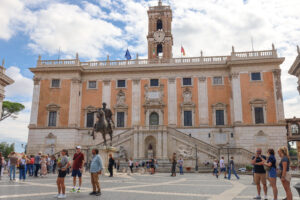
Keep walking a little bit further to get amazing views of Roman Forum. If you don’t want to walk the entire Ara Coeli staircase, then a shortcut is available from here.
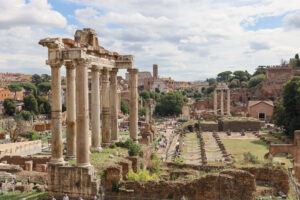
Vatican
Regardless of whether or not you are a religious person, a visit to the Vatican City is a must for anyone visiting Rome.
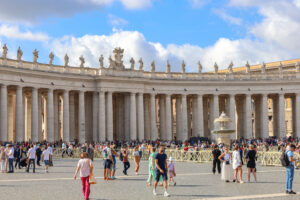
We were keen on getting a guided tour and understanding more of the history, so we booked ourselves on a guided tour on our first trip. We booked our tickets a whole month in advance and used this tour company.
There are some tour companies which offer guided tours as early as 7.30 am, almost 2 hours before the place opens to the public. Of course, they are more expensive than the ones offered at regular timings but if you are a photography enthusiast, then certainly worth looking into.
Our guided tour started at around 10 am and as we were walking through, we saw the serpentine queue of people lining up for tickets. And this was in April 2017! So even if you do not intend to do a guided tour, please buy tickets in advance. The last thing you want to do is waste your time standing in hour-long queues.
The Sistine Chapel, Michelangelo’s Pietà, Gallery of Maps and the other spots inside the Vatican and St. Peter’s Basilica will make your jaws drop! Every single piece of art and detail is simply breathtaking!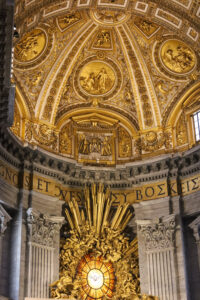
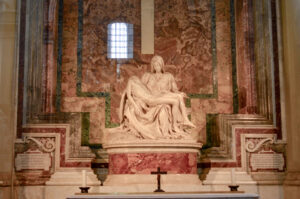
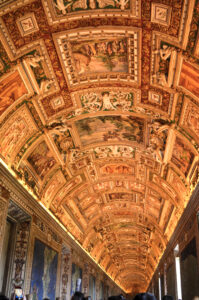
If you are on a guided tour, you get to know so much of the history! While guided tours are expensive, they are totally worth it specially in a place like this. There is so much to see that unless someone is guiding, you don’t really know what is important and what isn’t. Plus, getting a context of what you are looking at, makes it so much more meaningful.
Entry to St. Peter’s Basilica is free but there is security check, which again has a long queue. If you are on a guided tour, then you get to skip the line here. On our second visit in 2024, we ended up waiting in line for 45 minutes. Pro-tip – get here as soon as it opens or time your entry an hour before closing – that’s when it is the least crowded.
Once you are done with St Peter’s Basilica, you can climb to the top. The cupola of the Basilica is the highest point in the city and offers panoramic views of the Vatican City and all of Rome. You can buy tickets at the site.
Lastly, do not forget to dress modestly; there is a strict dress code in place so no miniskirts, shorts, or bare shoulders (for men, too). Girls, carry scarves or sarongs to hide those shoulders and knees.
Trevi Fountain
The Trevi Fountain is one of the most beautiful monuments in Rome. It is absolutely massive and at its center, there is a statue of Neptune, the Roman god of the sea and horses. Neptune stands in his shell-chariot which is drawn by a pair of horses.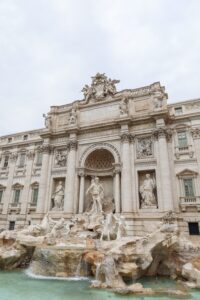
Making a wish at the Trevi Fountain is one of the most popular things to do. Stand with your back to the fountain and then toss a coin over your left shoulder with your right hand. Legend has it that throwing one, two or three coins into the fountain ensures that (a) you will return to Rome (b) you will fall in love with a Roman and (c) you will marry that Roman.
Trevi fountain is undoubtedly the MOST crowded spot in the city. If you want to experience the beauty of this place without the crowds then wake up early. With more and more instagammers trying to get that perfect shot, this spot is busy even at 7 am. So, the earlier the better. Or visit late in the night (well past midnight) and you will find fewer tourists then as well.
Pantheon
The Pantheon is a remarkable structure given its size, construction and design.
Though the Pantheon was originally built as a temple to all gods, it is now a Catholic church. The Pantheon is the best-preserved Roman monument, and to this day, it is in pristine condition.
As you are wandering around checking out the details, look up the dome. It is the largest unsupported dome in the world!
Entry to the Pantheon used to be free when we visited in 2017 but they have now started charging a fee. But the good thing is that each entry ticket comes with an audio guide.
We saw it from inside on our first visit in 2017 so didn’t bother going in this time.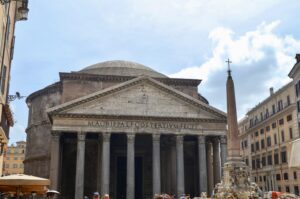
After visiting the Pantheon, grab a drink atthe lively Piazza di Rotonda. Hungry? Then, grab a sandwich at the all-famous All’ antico Vinaio, located 2 minutes from the Piazza.
Steps away from Pantheon, is one of the oldest coffee shops in Rome, Caffe Sant’Eustacho. This coffee shop is an institution in itself and no trip to Rome is complete without visiting this one for coffee lovers. You will see locals arriving and sipping their coffee in two minutes while the tourists are baffled by the variety of coffee.
Another place worth checking out is Galleria Doria Pamphilj located near the Pantheon. It houses Rome’s largest private collection, a trove assembled by the Doria, Pamphilj, Landi, and Aldobrandini families. The collection mainly features oil paintings and sculptures, but there are frescoes painted on the walls, as well. Most of the palace’s frescoes and furnishings date to the 17th century. Entry fee is €17 per person.
Piazza Navona
Piazza Navona is one of the most beautiful squares in Rome. It is built at the site where the Stadium of Domitian (Circus Agonalis, founded in 86 AD), once stood. It could hold approximately 20,000 spectators, who came here to see different athletic competitions.
The most beautiful parts of Piazza Navona are its three fountains. On one side you see a large fountain dedicated to Neptune while the other end depicts dolphins and tritons. At the heart, you will see a tall obelisk reaching out from Bernini’s Fountain of the Four Rivers.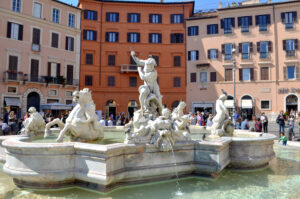
This square is surrounded by cafes and restaurants and the whole Piazza has a lively atmosphere during the day. You can even enjoy performances by street artists like magicians and dancers.
No matter what time it is, this piazza is always a hub of activity and people. It is a great place to people watch and enjoy your daily gelato.
Oh and the best tiramisu in town, Two Sizes is literally steps away from this Piazza.
Spanish Steps
After the Colosseum, Vatican and Trevi Fountain, the most popular spot in Rome is the Spanish Steps. The Italian name is “Scalinata della Trinità dei Monti” and comprises 12 ramps and 135 steps. It is the widest and longest staircase of Europe. But it is no longer possible to sit on the stairs, you might get a fine if you do so!
At the centre of the square facing the staircase is the “Barcaccia” i.e. boat. 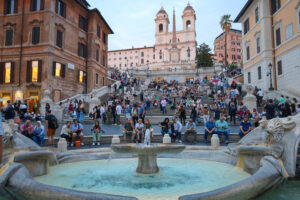
About 5-7 minutes away from the Spanish steps, is this absolutely gorgeous street, Via Margutta. It is probably just three blocks but goes back 2,000 years. Mostly residential, lined with ivy, cobblestones and window boxes, art galleries and artists’ studios, it is one of the most charming little street in Rome. Via Margutta runs parallel with one of the streets that lead from Piazza di Spagna to Piazza del Popolo. It is a peaceful oasis away from the hustle and bustle of the main streets. It is such a charming street to walk along and is full of little shops and studios. Definitely worth taking the short detour to walk along this beautiful street.

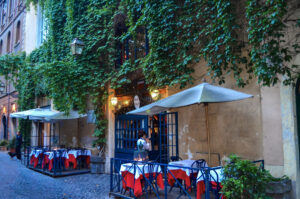
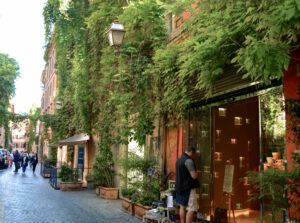
Fun fact – When I went back to capture photos here on my recent trip, there was a Bollywood movie shoot going on and I spotted my favorite actor😊 Sadly it was blocked so couldn’t take any photos of the street this time☹️
Located close to the Spanish Steps is yet another famous tiramisu store – Pompii. Check it out if you like tiramisu.
Castel Sant’ Angelo
Originally the mausoleum of Emperor Hadrian, Castel Sant’angelo transformed into a fortress, prison and is now a historical attraction. From stunning architecture to breathtaking views of Rome’s skyline, it pulls in millions of tourists every year.
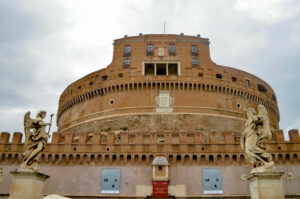
The castle offers not one, but three impressive viewpoints. The rooftop terrace with the angel statue showcases the best panoramic view of Rome, while a coffee shop and another viewpoint provide different but equally fascinating views.
The statue of the angel atop the castle was destroyed multiple times by various calamities. The current bronze statue was installed in 1753.
Entry fee to Castel Sant’ Angelo is €18.
Even if you don’t want to visit from inside, walk over Ponte St. Angelo bridge, past Castel St. Angelo. The views of Vatican from this vantage point are simply spectacular. You can even enjoy a magnificent view of the Vatican City and River Tiber. It was completely covered in scaffolding on our last visit☹️
You can also make a small detour to Ponte Vittorio Emanuele II for a beautiful view of the castle and Ponte Sant’Angelo.
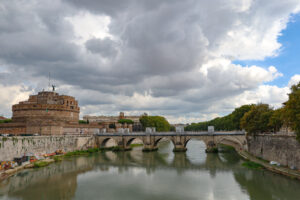
Trastevere
This is one authentic Italian neighborhood you would not want to miss!
Trastevere literally means across the River Tiber. It has always been home to craftsmen, artists, and immigrants. Today, you see a lot of tourists crowding Trastevere’s narrow streets. It has become one of Rome’s most popular neighborhoods and is known for its great restaurants, pubs, and nightlife.
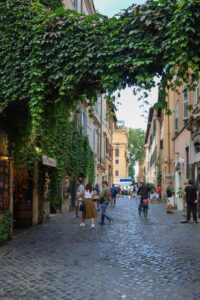
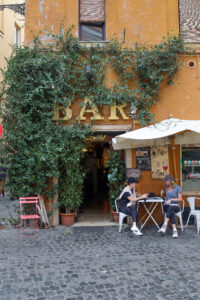
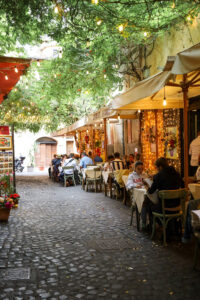
Once you get to Trastevere, head towards Piazza di Santa Maria, take Via del Moro, with its many shops and cafes, then divert into the quiet cobblestoned side streets lined with ivy and terracotta-colored facades. At the piazza, join the locals and tourists and take a seat on the steps of the fountain – a great spot for people-watching.
As you lose yourself down the winding cobblestone streets, you will realise why everyone falls in love with this magnificent neighborhood. From romantic winding alleyways and cobblestone streets to magestic churches and beautiful piazzas, there is beauty in every corner!
Be sure to visit Santa Maria, one of the oldest churches in Rome, supposedly built around 350 AD. It boasts impressive mosaics from the 12th and 13th centuries so if you are a mosaic lover, don’t miss it.
One of the best parts about Trastevere is the amazing array of food choices that one has in this neighborhood. The area is filled with pizzeria, cafès, mom and pop trattorie, dance clubs, sidewalk vendors, and pubs and is an ideal way to begin or end the day.
We first went to Trastevere for dinner on our first night in Rome in 2017. But we loved the neighborhood so much that we had to go back the next morning to see the neighborhood in broad daylight. And of course, I spent a lovely afternoon here on my recent trip in 2024 ! Needless to say, Trastevere is a photographer’s delight!
And Trastevere was probably the only part of the city which didn’t have any Jubilee year construction work going on – Hallelujah !!
Villa Borghese
If you are keen to explore some of the lesser-known places then check out Villa Borghese. It is the most popular park in Rome and is considered its green lung.
Entry to the gardens is free of charge. Apart from the gardens, you can check out the lake as well. You can rent a boat and row around the lake and to the Temple of Asclepius. It costs €5 for 20 minutes.
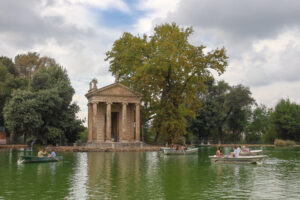

If you want to visit Galleria Borghese, then you must book the tickets in advance. This galleria is home to world-famous sculptures and paintings by Bernini, Caravaggio, Raphael, Rubens, Botticelli and many other noted men.
Sunset Spots
Here are some places which offer spectacular views of the city during sunset hour.
Terraza del Pincio
It is a part of the Villa Borghese Gardens and is also steps away from Spanish Steps.
Looking over the Piazza del Popolo, you can clearly see the Vatican and St Peter’s Basilica. Bring your own drinks and snacks and find a spot from where you can watch the sky turn into orange!
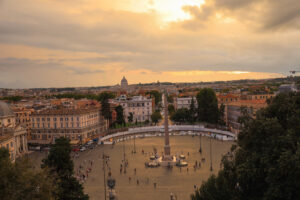
Also, check out the view from Terraza Viale del Belvedere, located just few steps away from Terraza del Pincio. You can even spot the wedding cake monument from here.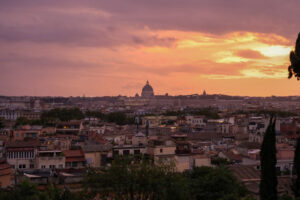

Janiculum Hill
Being the highest hill in Rome, you are guaranteed a stunning panoramic view of the city. From the top of the hill, you can see some of Rome’s most famous landmarks, such as St. Peter’s Basilica and the Colosseum. The view is particularly beautiful at sunset, as the colors of the sky change and the city is bathed in a warm, golden light.
Ponte Umberto I
A few steps away from Castel Sant’ Angelo lies Ponte Umberto I. While there are many bridges that connect the banks of the Tiber, this 19th-century structure is one of the most impressive. It provides a beautiful vantage point of St. Peter’s Basilica specially during sunset time.

Spanish Steps
Climb all the way up the staircase and be ready to be wowed by the views from the top. Also, while the Steps are generally crowded, we found very few people here at the top.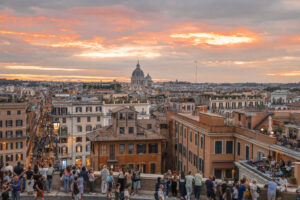
Giardino degli Aranci
Tourists and locals alike head to Giardino degli Aranci (the Orange Garden) to take in the sunset. From here you’ll get a picture-perfect view of St Peter’s Dome as the sun sets.
Other Lesser-known Basilicas
While everyone flocks to the Vatican and St Peter’s Basilica for obvious reasons, during our second time in Rome, we wanted to visit some of the lesser-known Basilicas. The details here are just as ornate and will make your jaws drop. So, if you have additional time on hand after all the sight-seeing, definitely worth checking out.
The Basilica di Santa Maria Maggiore
As the largest of the churches in Rome dedicated to the Virgin Mary, this is one of the city’s most important basilicas. Filled with artefacts and art, every inch of the church seems to be a part of religious history. It is one of the oldest churches in Rome, built around 440.
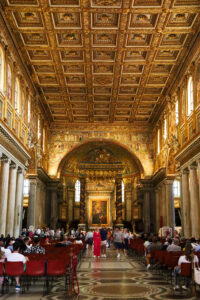
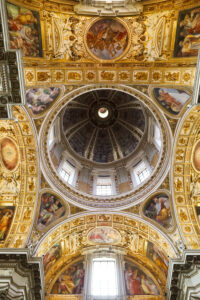
Santa Maria Sopra Minerva
Built in the 13th century, it is one of Rome’s few Gothic (as opposed to Baroque-style) churches in Italy.
Basilica of Santa Maria del Popolo
Most tourists overlook this inconspicuous church in the large Piazza del Popolo, but the inside is a treasure trove for art lovers. The church has seven chapels, each of which contain some of the best examples of works by Renaissance artists, including Pinturicchio, Raphael, Bernini and Caravaggio.
The Church of St. Ignatius of Loyola
This one has risen to fame thanks to its popularity on social media. I am sure you must have seen the famous mirror all over Instagram!
What earlier used to be a hidden gem, is now a popular photo spot. So don’t be surprised if you encounter lengthy queues here, which can easily take upwards of 30-40 minutes. The church has now also implemented a one euro fee to gaze into the mirror. After inserting a coin into the adjacent slot, you will have one minute to enjoy the gorgeous reflection before the view becomes obstructed with a foggy haze.
Explore the City by Night
Marvel at the glow of the Colosseum and the enchanting ruins of the Forum. Do visit Trevi fountain, Spanish Steps and Piazza Navona during the day and the evening when the buildings and fountains are beautifully lit up!
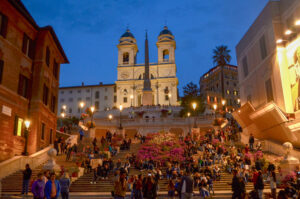

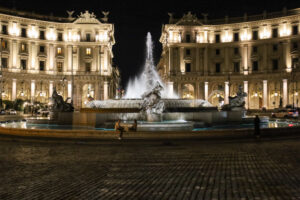
General tips
- Entrance is free to all major attractions (such as the Colosseum, Forum, Palantine Hill, National Museum of Castel Sant’Angelo, etc.) on the first Sunday of the month. AVOID THIS DAY AT ALL COSTS.
- While you may want to have a perfect Italian meal at one of the high-end restaurants, pizza by the slice at one of the many bakeries or “fornos” that line the periphery, along with the cafés and gelaterias, is equally yummy and always makes for the perfect snack!
- If you intend to do a guided tour of the Colosseum and/ or Vatican, book your tickets in advance. Note that we booked our tour of the Vatican a month in advance. We lucked out in getting Colosseum guided tour tickets on the day of visit itself but that was way back on 2017. Not sure if you can get last minute tickets now unless you are ready to shell out €€€.
*All prices mentioned are as of September 2024
